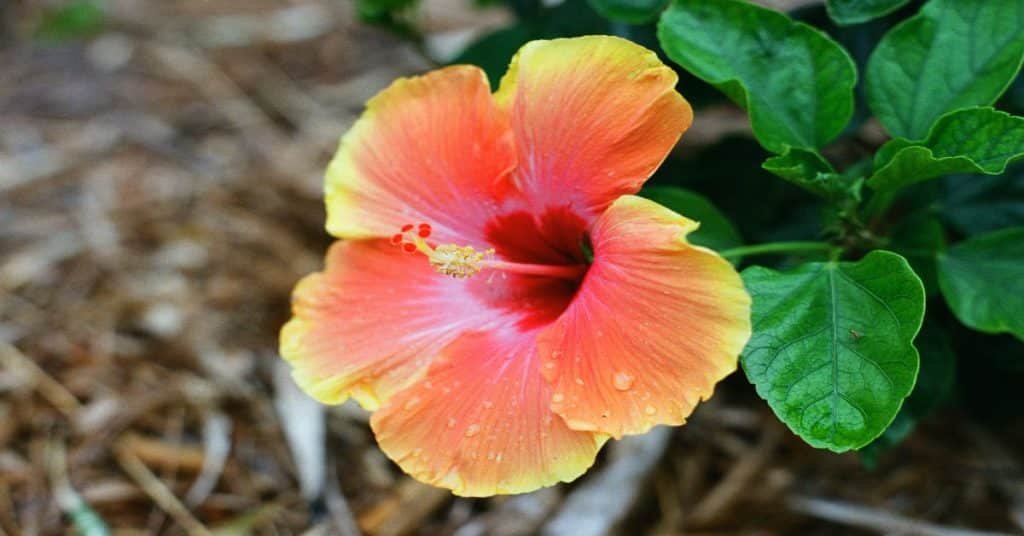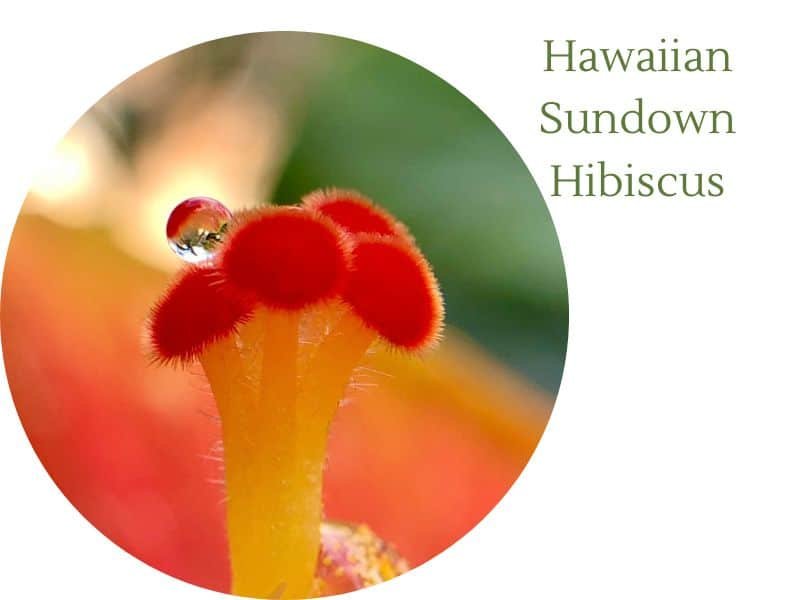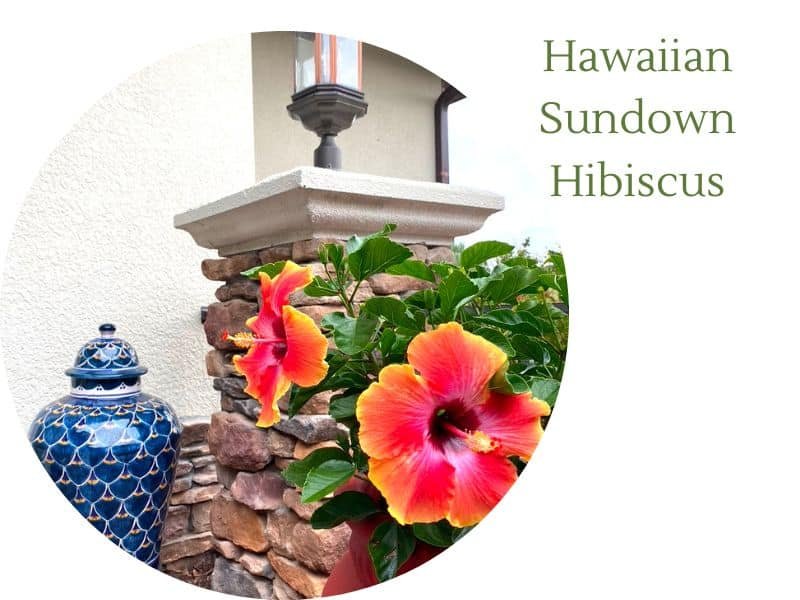Are you looking for a statement plant that will turn heads and make your garden look like it’s straight out of paradise? Look no further than the stunning Hawaiian Sundown Hibiscus.

This tropical beauty is sure to draw attention with its vibrant red and pink hues, making it a must-have for any plant enthusiast. But the Hawaiian Sundown Hibiscus isn’t just a pretty face – this plant is also critical to care for if you want it to thrive.
Table of Contents
Brief Overview of Hawaiian Sundown Hibiscus
The Hawaiian Sundown Hibiscus (Hibiscus rosa-sinensis), also known as the Sunset hibiscus, is a gorgeous tropical shrub that produces large, showy flowers in shades of red and pink with deep maroon centers. These flowers are unmistakable and can measure up to 8 inches in diameter!
It’s often found growing in tropical regions such as Hawaii, Florida, as well as other South Pacific destinations. One of the things that makes this particular type of hibiscus so special is that it’s a hybrid variety with unique characteristics.
It was created by crossing two different species of hibiscus plants to produce something truly remarkable. The result was an explosion of color unlike anything seen before in the Hibiscus family.
The Importance of Caring for Your Hawaiian Sundown Hibiscus
Let me be clear: caring for your hibiscus isn’t just important; it’s absolutely vital if you want this beautiful plant to thrive. Neglecting your plants can lead to poor health, stunted growth, and even death! And when it comes to the Hawaiian Sundown Hibiscus specifically – well, let’s just say that this darling beauty needs some serious TLC.
It may come as a surprise to many gardeners but the Hawaiian Sundown Hibiscus has a relatively short lifespan of only about five years. So, if you want your plant to last as long as possible, it’s important to provide it with the proper care that will keep it healthy and happy throughout its lifetime.
In addition to its relatively short lifespan, this particular variety of hibiscus is also somewhat sensitive and can be prone to certain diseases, pests, and other issues. This makes proper care all the more important if you want to keep your plant in tip-top shape.
So there you have it: an introduction to the stunning Hawaiian Sundown Hibiscus and why caring for this plant is so important. Stay tuned for tips on how to care for your hibiscus!
What is the Hawaiian Sundown Hibiscus?

Although the name of this flower indicates Hawai, this stunning plant is native to Vanuatu and not related to the Hawai region species of Hibiscus. The Hawaiian Sundown Hibiscus has large, deep red flowers with a yellow center, which make it an exceptional showpiece in any garden.
Description of the Plant’s Appearance and Characteristics
The Hawaiian Sunset Hibiscus can grow up to 8 feet tall and 6 feet wide, making it an ideal plant for those who want a bold statement piece in their garden. One of its most attractive features is its large, deep red flowers with yellow centers, which are sure to catch anyone’s eye. The leaves are dark green in color, creating a stunning contrast between foliage and bloom.
In addition to its beauty, this hibiscus variety is also disease-resistant and easy to care for when properly tended. It requires full sunlight exposure during the day for at least 6 hours per day, as well as well-draining soil that doesn’t hold too much moisture.
The Birth of the Hawaiian Sunset Hibiscus
The Hawaiian Sunset Hibiscus, scientifically known as Hibiscus rosa-sinensis, is an enchanting flower that originated in the picturesque islands of Vanuatu. Known for its vibrant colors and graceful appearance, this hibiscus cultivar has captured the hearts of people worldwide.
Cultural Significance
In Vanuatu’s rich cultural heritage, the hibiscus flower holds a special place. It is often used to symbolize the beauty and spirit of the islands. The Hawaiian Sunset Hibiscus, with its stunning hues of red, orange, and yellow, evokes the mesmerizing beauty of a tropical sunset, reflecting the radiant splendor of Vanuatu’s natural landscapes.
For generations, the people of Vanuatu have embraced the hibiscus flower for various purposes. Its petals have been utilized in traditional ceremonies, and the flower itself has become a symbol of hospitality and friendship. The vibrant colors of the Hawaiian Sunset Hibiscus have also inspired numerous artists, poets, and writers throughout history, celebrating the allure and natural wonders of Vanuatu’s floral treasures.
The Naming
The Hawaiian Sunset Hibiscus acquired its name due to its popularity and association with Hawaii, despite its actual origin in Vanuatu. This phenomenon often occurs in the plant world, where certain species or cultivars become closely linked to a specific region or culture, even if they didn’t originate there.
In the case of the Hawaiian Sunset Hibiscus, it is believed that the cultivar was likely introduced to Hawaii at some point in the past, where it gained recognition and popularity among the locals and visitors. As a result, it became commonly referred to as the “Hawaiian” Sunset Hibiscus, associating it with the Hawaiian islands, despite its true origin in Vanuatu.
The naming of plants can sometimes be influenced by factors such as commercial marketing, regional preferences, or cultural associations. In this case, the captivating beauty of the flower and its vibrant colors reminiscent of a Hawaiian sunset likely contributed to the adoption of the name “Hawaiian Sunset Hibiscus.”
How to Care for Your Hawaiian Sundown Hibiscus

Light Requirements and Placement Suggestions: Sun-kissed Beauty
Okay people, listen up. If you want your Hawaiian Sundown Hibiscus to thrive, you need to give it some serious sunshine. This plant is not for the faint of heart – it requires at least six hours of direct sunlight every day.
That means finding the perfect spot in your yard or on your patio where it can bask in all its glory. Don’t try to cheat by putting it in a shady corner and hoping for the best – this plant needs its daily dose of vitamin D.
So, where should you place your hibiscus? Well, folks, there’s no hard and fast rule here.
Just make sure that wherever you put it, it gets plenty of sunshine and isn’t obstructed by other plants or structures. Some people like to put their hibiscus in pots so they can move them around more easily, but if you’re planting directly in the ground make sure there’s enough space for growth.
Watering Needs and Tips for Proper Hydration: Hydration Station
Ah yes, water – the elixir of life! Your Hawaiian Sundown Hibiscus needs regular watering to stay healthy and vibrant.
But beware – overwatering can be just as deadly as underwatering! So how much water does this plant need?
Well, folks, that depends on a few factors like temperature and humidity levels. As a general rule of thumb, aim to keep the soil moist but not soggy.
Check the soil regularly by sticking your finger about an inch into it – if it feels dry then water away! One pro tip: use room temperature water instead of cold water straight from the tap.
Cold water can shock the roots and cause damage – not good! And remember, don’t water the leaves or flowers directly – just the soil around the base of the plant.
Soil Preferences and Fertilization Techniques: Soil Secrets
Last but not least, let’s talk about soil. Your Hawaiian Sundown Hibiscus deserves the very best, so make sure you’re giving it a good foundation with high-quality soil.
This plant prefers well-draining soil that’s slightly acidic – think pH levels between 5.5 and 6.5. If your soil is too alkaline, you can lower the pH by adding elemental sulfur or aluminum sulfate.
Or check our article if you want to find plants that love this type of soil: https://harvestindoor.com/flowers-that-like-alkaline-soil/
But wait, there’s more! To really give your hibiscus a boost, try fertilizing it every 2-3 months during the growing season (typically spring through fall).
Use a balanced fertilizer with equal amounts of nitrogen, phosphorus, and potassium. And remember folks, less is often more when it comes to fertilizing – don’t go overboard or you’ll risk damaging those delicate roots!
Pests, Diseases, and Other Issues to Watch Out For
Common pests that attack hibiscus plants
Let me tell you about the horrendous pests that can invade your beautiful Hawaiian Sundown Hibiscus. The first culprit is the spider mite. These tiny creatures are almost invisible to the naked eye, but they can do a lot of damage to your plant.
They suck the sap out of your leaves, causing them to turn yellow and eventually fall off. Another pest you need to watch out for is the whitefly.
These little buggers love to lay their eggs on the underside of your plant’s leaves and will quickly multiply if left unchecked. They cause yellowing and wilting of leaves, leading to severe damage and sometimes even death of your hibiscus.
Diseases that can affect your Hawaiian Sundown Hibiscus
In addition to pests, diseases can also wreak havoc on your hibiscus plant. One common disease is powdery mildew.
This fungal disease forms a white powdery substance on leaves and stems, hindering photosynthesis and ultimately leading to leaf drop or stunted growth in severe cases. Root rot is another disease that can be fatal for Hawaiian Sundown Hibiscus plants if not recognized early enough whereby roots become mushy due to lack of proper drainage.
Tips on how to prevent these issues from occurring
To avoid pests and diseases from destroying all of your hard work in cultivating a beautiful Hawaiian Sundown Hibiscus, prevention is key! The best way to prevent these issues is by maintaining a clean growing environment free from debris like fallen leaves which may harbor pests or diseases too.. Regularly check up on your plant by inspecting it closely for any signs of infestation or infection mentioned above so as take necessary action at early stages. Insecticidal soap and horticultural oil can be sprayed on plants to control pests but it should be used sparingly as overuse may also cause damage to plant foliage.
Additionally, ensure your hibiscus is planted in well-drained soil and not over-watered to prevent root rot. Remember that prevention is always better than cure!
Propagation Techniques for Your Hawaiian Sundown Hibiscus

If you are interested in expanding your collection of Hawaiian Sundown Hibiscus, propagation is an excellent way to go. There are a few ways to propagate your plant, but the most common methods are through cuttings or seeds.
Cuttings
One of the easiest and most reliable ways to propagate your plant is through stem cuttings. To do this, simply cut off a portion of the stem with a clean pair of pruning shears. Make sure that the cutting is at least 4-6 inches long and has several nodes on it.
Once you have your cutting, strip off any leaves or flowers from the bottom half of the stem and dip them in the rooting hormone. This will help stimulate root growth.
Then, plant the cutting in a pot filled with well-draining soil and water thoroughly. Keep the soil moist but not soaking wet and place it in an area that receives bright but indirect light.
Seeds
Growing Hawaiian Sundown Hibiscus from seeds can be a bit more challenging than using cuttings, but it can also be rewarding. To start, collect mature seeds from your plant when they are ready to harvest. Use fresh potting soil and plant each seed about an inch deep into the soil.
Make sure to keep the soil moist during germination by misting it regularly or covering it with plastic wrap until seedlings emerge. Once they do, remove any plastic wrap or covering you used to let them breathe better.
Creative Section: “Growing Your Collection”
If you’re passionate about gardening or just love collecting beautiful plants like me, then expanding your collection of Hawaiian Sundown Hibiscus is something you’ll definitely want to consider! I recommend propagating several plants at once so that you can experiment with different techniques and see which one works best for you. Not only will this give you a chance to learn more about the plant and its growth habits, but it will also help you create a stunning display in your garden or home.
Once your new plants are established, consider arranging them differently to create unique displays. For example, you could group them together in a cluster or arrange them in a line for an eye-catching border.
You could also try planting them in different-sized pots or containers to add some variety to your collection. Propagating Hawaiian Sundown Hibiscus is an excellent way to expand your collection and create a beautiful display of these stunning plants.
Whether you choose to use cuttings or seeds, make sure to follow the proper techniques for success. And be creative with how you display your new plants!
Conclusion
In this article, we have explored the beautiful and exotic Hawaiian Sundown Hibiscus plant. We have learned about its unique appearance and characteristics, its origin and history, and most importantly, how to care for it. It is clear that this plant is not only aesthetically pleasing but also requires a great deal of attention and care to thrive.
The Hawaiian Sundown Hibiscus requires bright sunlight exposure for several hours each day with moderate watering needs. The soil should be well-drained, rich in nutrients, and fertilized regularly to promote healthy growth.
Despite being hardy plants, hibiscus plants are susceptible to pest infestations and diseases if not cared for properly. It is important to remember that plants are living beings that require constant attention just like any other member of our household or family.
Therefore, we must be diligent in our approach to caring for them. In the case of the Hawaiian Sundown Hibiscus plant, we must create an environment that mimics its natural habitat by providing ample sunlight exposure and regular watering.
Growing a Hawaiian Sundown Hibiscus can bring beauty and vitality into your home or garden. By following the tips outlined in this article on how to care for this amazing plant you will ensure its survival as an exotic addition to your collection of indoor or outdoor plants while adding a touch of tropical paradise wherever you choose to cultivate it!

Gardening is my passion and growing plants indoors has always been a stress relief for me. Grow a banana tree in my apartment once (although failed to produce bananas).






